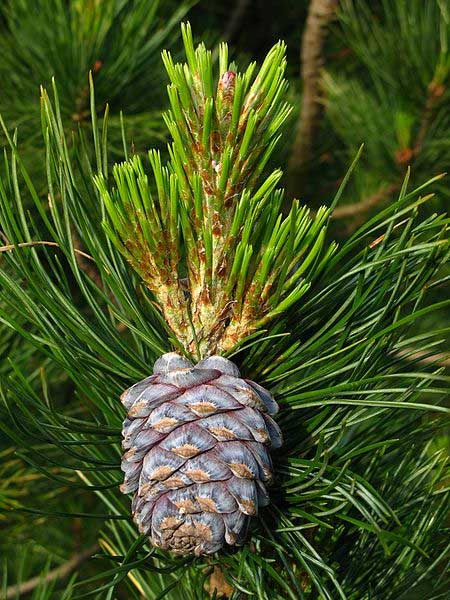
Pinus sibirica (*)
Superregnum: Eukaryota
Regnum: Plantae
Divisio: Tracheophyta
Divisio: Pinophyta
Classis: Pinopsida
Ordo: Pinales
Familia: Pinaceae
Genus: Pinus
Subgenus: P. subg. Strobus
Sectio: P. sect. Quinquefoliae
Subsectio: P. subsect. Strobus
Species: Pinus sibirica
Name
Pinus sibirica Du Tour in J.-F.-P.Déterville, Nouv. Dict. Hist. Nat. 18: 18 (1803).
Synonyms
Homotypic
Pinus cembra var. sibirica (Du Tour) G.Don in J.C.Loudon, Hort. Brit.: 387 (1830).
Pinus cembra subsp. sibirica (Du Tour) Krylov, Fl. Alt. 7: 1724 (1914).
Pinus cembra var. sibirica (Du Tour) A.E.Murray, Kalmia 13: 22 (1983).
Heterotypic
Pinus coronans Litv., Trudy Bot. Muz. Imp. Akad. Nauk 11: 23 (1913).
Pinus cembra f. kairamoi Schwer., Mitt. Deutsch. Dendrol. Ges. 36: 185 (1926).
Pinus cembra f. coronans (Litv.) Krylov, Fl. Zapadno? Sibiri 1: 79 (1927).
Pinus arolla Petrov, Fl. Iakut.: 63 (1930).
Pinus hingganensis H.J.Zhang, Bull. Bot. Res., Harbin 5(1): 151 (1985).
Pinus sibirica var. hingganensis (H.J.Zhang) Silba, Phytologia 68: 61 (1990).
Pinus sibirica subsp. hingganensis (H.J.Zhang) Silba, J. Int. Conifer Preserv. Soc. 16: 33 (2009).
Homonyms
Pinus sibirica (Ledeb.) Turcz., Bull. Soc. Imp. Naturalistes Moscou 11: 101 (1838), nom. illeg. is a synonym of Abies sibirica Ledeb.
Pinus sibirica (Ledeb.) Münchh., Hausvater 5: 226 (1770). is a synonym of Larix sibirica Ledeb.
Distribution
Native distribution areas:
Asia-Temperate
China
Inner Mongolia [Nei Mongol], Manchuria [Heilongjiang], Xinjiang.
Middle Asia
Kazakhstan
Mongolia
Mongolia
Siberia
Altay, Buryatiya, Chita, Irkutsk, Krasnoyarsk, West Siberia, Tuva, Yakutiya
References: Brummitt, R.K. 2001. TDWG – World Geographical Scheme for Recording Plant Distributions, 2nd Edition
References
Komarov, V.L. et al. (eds.). 1934–1964. Flora SSSR. 30 vols. Moscow/Leningrad: Botanicheskii institut, Izdatel'stvo Akademii Nauk SSSR. Reference page.
Wu Zhengyi, Raven, P.H. & Hong Deyuan (eds.) 1994–2013. Flora of China. 25 vols. Science Press, Beijing & Missouri Botanical Garden Press, St. Louis. Online at eFloras.org Reference page.
Farjon, A. 2010. A Handbook of the World's Conifers. Koninklijke Brill, Leiden. ISBN 90-04-17718-3. Reference page.
Farjon, A. 2013.. Pinus sibirica. The IUCN Red List of Threatened Species 2013. IUCN Red List Category: Least Concern. DOI: 10.2305/IUCN.UK.2013-1.RLTS.T42415A2978539.en.
International Plant Names Index. 2019. Pinus sibirica. Published online. Accessed: 21 July 2019.
Vernacular names
azərbaycanca: Sibir sidrağacı
беларуская: Хвоя сібірская кедравая
буряад: Хуша
català: Pi de Sibèria
čeština: borovice sibiřská
Deutsch: Sibirische Zirbelkiefer
English: Siberian Pine
Esperanto: Siberia pino
eesti: Siberi seedermänd
فارسی: کاج سیبری
français: Pin de Sibérie
íslenska: Síberíufura
italiano: Pino siberiano
ქართული: ციმბირული ფიჭვი
қазақша: Самырсын қарағай
перем коми: Суспу
lietuvių: Sibirinė pušis
Nederlands: Siberische den
norsk nynorsk: Sibirfuru
norsk: Sibirfuru
polski: Sosna syberyjska
русский: Сосна сибирская кедровая
саха тыла: Луҥту
Türkçe: Sibirya çamı
удмурт: Сибирьысь кедр
українська: Сосна сибірська
Tiếng Việt: Thông Siberi
中文: 新疆五针松
Pinus sibirica, or Siberian pine, in the family Pinaceae is a species of pine tree that occurs in Siberia from 58°E in the Ural Mountains east to 126°E in the Stanovoy Range in southern Sakha Republic, and from Igarka at 68°N in the lower Yenisei valley, south to 45°N in central Mongolia.
Distribution
In the north of its range, it grows at low altitudes, typically 100–200 m, whereas further south, it is a mountain tree, growing at 1,000-2,400 m altitude. It often reaches the alpine tree line in this area. The mature size is up to 30–40 m height, and 1.5 m trunk diameter. Its maximum lifetime is 800–850 years.
Description
Flowering pine cones
Pinus sibirica is a member of the white pine group, Pinus subgenus Strobus, and like all members of that group, the leaves ('needles') are in fascicles (bundles) of five, with a deciduous sheath. They are 5–10 cm long. Siberian pine cones are 5–9 cm long. The 9–12 mm long seeds have only a vestigial wing and are dispersed by spotted nutcrackers.
Siberian pine is treated as a variety or subspecies of the very similar Swiss pine (Pinus cembra) by some botanists. It differs in having slightly larger cones, and needles with three resin canals instead of two in Swiss pine.
Like other European and Asian white pines, Siberian pine is very resistant to white pine blister rust (Cronartium ribicola). This fungal disease was accidentally introduced from Europe into North America, where it has caused severe mortality in the American native white pines in many areas, notably the closely related whitebark pine. Siberian pine is of great value for research into hybridisation and genetic modification to develop rust resistance in these species.
Cultivation
Young trees growing in a park
Siberian pine, Pinus sibirica, is a popular ornamental tree in parks and large gardens where the climate is cold, such as central Canada, giving steady though not fast growth on a wide range of sites. It is very tolerant of severe winter cold, hardy down to at least –60 °C, and also of wind exposure.
The seeds are also harvested and sold as pine nuts, which in Russia are marketed as Cedar nuts (Russian: Кедровые орехи).
"Siberian cedar"
The Russian name Сибирский кедр (tr. Sibirsky kedr)[3] is usually translated in English as “Siberian cedar.” References to “cedar” or "dwarf cedar" in texts translated from Russian usually refer to this tree or related pines, not to true cedars.
Chemistry
Pinostilbene is a stilbenoid found, along with resveratrol, in the bark of P. sibirica.[4]
See also
Kuznetsk Alatau 3.jpg Siberia portal
Pinus pumila × P. sibirica
References
Farjon, A. (2013). "Pinus sibirica". The IUCN Red List of Threatened Species. IUCN. 2013: e.T42415A2978539. doi:10.2305/IUCN.UK.2013-1.RLTS.T42415A2978539.en. Retrieved 13 December 2017.
"The Plant List: A Working List of All Plant Species".
"Кедровая сосна" [Cedar pine]. Great Russian Encyclopedia (in Russian). Vol. 13. Moscow. 2009. p. 783. ISBN 978-5-85270-344-6. Retrieved 2018-01-16.
Hydroxystilbenes from the bark of Pinus sibirica. N. A. Tyukavkina, A. S. Gromova, V. I. Lutskii and V. K. Voronov, Chemistry of Natural Compounds, September 1972, Volume 8, Issue 5, pages 570-572, doi:10.1007/BF00564298
Retrieved from "http://en.wikipedia.org/"
All text is available under the terms of the GNU Free Documentation License

